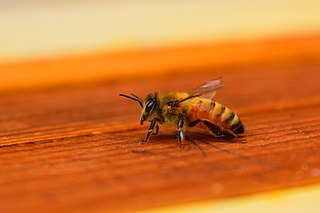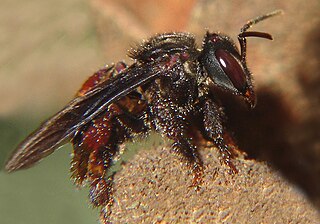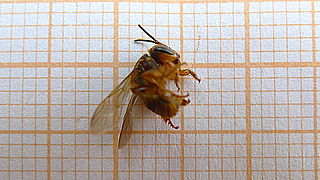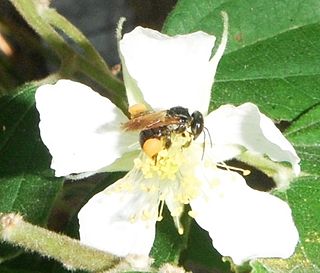Related Research Articles

A honey bee is a eusocial flying insect within the genus Apis of the bee clade, all native to mainland Afro-Eurasia. After bees spread naturally throughout Africa and Eurasia, humans became responsible for the current cosmopolitan distribution of honey bees, introducing multiple subspecies into South America, North America, and Australia.

A queen bee is typically an adult, mated female (gyne) that lives in a colony or hive of honey bees. With fully developed reproductive organs, the queen is usually the mother of most, if not all, of the bees in the beehive. Queens are developed from larvae selected by worker bees and specially fed in order to become sexually mature. There is normally only one adult, mated queen in a hive, in which case the bees will usually follow and fiercely protect her.
The Nasonovpheromone is released by worker bees to orient returning forager bees back to the colony. To broadcast this scent, bees raise their abdomens, which contain the Nasonov glands, and fan their wings vigorously.

A laying worker bee is a worker bee that lays unfertilized eggs, usually in the absence of a queen bee. Only drones develop from the eggs of laying worker bees. A beehive cannot survive with only a laying worker bee.

The dwarf honey bee, Apis florea, is one of two species of small, wild honey bees of southern and southeastern Asia. It has a much wider distribution than its sister species, Apis andreniformis. First identified in the late 18th century, Apis florea is unique for its morphology, foraging behavior and defensive mechanisms like making a piping noise. Apis florea have open nests and small colonies, which makes them more susceptible to predation than cavity nesters with large numbers of defensive workers. These honey bees are important pollinators and therefore commodified in countries like Cambodia.

Apis andreniformis, or the black dwarf honey bee, is a relatively rare species of honey bee whose native habitat is the tropical and subtropical regions of Southeast Asia.

The East African lowland honey bee is a subspecies of the western honey bee. It is native to central, southern and eastern Africa, though at the southern extreme it is replaced by the Cape honey bee. This subspecies has been determined to constitute one part of the ancestry of the Africanized bees spreading through North and South America.

Nasonov's gland produces a pheromone used in recruitment in worker honeybees. The pheromone can serve the purposes of attracting workers to a settled swarm and draw bees who have lost their way back to the hive. It is used to recruit workers to food that lacks a characteristic scent and lead bees to water sources. The gland is located on the dorsal side of the abdomen. Its opening is located at the base of the last tergite at the tip of the abdomen.

The western honey bee or European honey bee is the most common of the 7–12 species of honey bees worldwide. The genus name Apis is Latin for "bee", and mellifera is the Latin for "honey-bearing" or "honey carrying", referring to the species' production of honey.
The genetics of social behavior is an area of research that attempts to address the question of the role that genes play in modulating the neural circuits in the brain which influence social behavior. Model genetic species, such as D.melanogaster and Apis mellifera, have been rigorously studied and proven to be instrumental in developing the science of genetics. Many examples of genetic factors of social behavior have been derived from a bottom-up method of altering a gene and observing the change it produces in an organism. Sociogenomics is an integrated field that accounts for the complete cellular genetic complement of an organism from a top-down approach, accounting for all biotic influences that effect behavior on a cellular level.

Apis cerana, the eastern honey bee, Asiatic honey bee or Asian honey bee, is a species of honey bee native to South, Southeast and East Asia. This species is the sister species of Apis koschevnikovi and both are in the same subgenus as the western (European) honey bee, Apis mellifera. A. cerana is known to live sympatrically along with Apis koschevnikovi within the same geographic location. Apis cerana colonies are known for building nests consisting of multiple combs in cavities containing a small entrance, presumably for defense against invasion by individuals of another nest. The diet of this honey bee species consists mostly of pollen and nectar, or honey. Moreover, Apis cerana is known for its highly social behavior, reflective of its classification as a type of honey bee.
Varroa sensitive hygiene (VSH) is a behavioral trait of honey bees (Apis mellifera) in which bees detect and remove bee pupae that are infested by the parasitic mite Varroa destructor. V. destructor is considered to be the most dangerous pest problem for honey bees worldwide. VSH activity results in significant resistance to the mites.

Trigona spinipes is a species of stingless bee. It occurs in Brazil, where it is called arapuá, aripuá, irapuá, japurá or abelha-cachorro ("dog-bee"). The species name means "spiny feet" in Latin. Trigona spinipes builds its nest on trees, out of mud, resin, wax, and assorted debris, including dung. Therefore, its honey is not fit for consumption, even though it is reputed to be of good quality by itself, and is used in folk medicine. Colonies may have from 5,000 to over 100,000 workers.
Queen retinue pheromones (QRP) are a type of honey bee pheromones, so-called because one of their behavioral effects is to attract a circle of bees around the queen.

Bumblebees, like the honeybee collect nectar and pollen from flowers and store them for food. Many individuals must be recruited to forage for food to provide for the hive. Some bee species have highly developed ways of communicating with each other about the location and quality of food resources ranging from physical to chemical displays.

Melipona beecheii is a species of eusocial stingless bee. It is native to Central America from the Yucatán Peninsula in the north to Costa Rica in the south. M. beecheii was cultivated in the Yucatán Peninsula starting in the pre-Columbian era by the ancient Maya civilization. The Mayan name for M. beecheii is xunan kab, which translates roughly to "regal lady bee". M. beecheii serves as the subject of various Mayan religious ceremonies.

Scaptotrigona postica is a species of stingless bee that lives mainly in Brazil. It is a eusocial bee in the tribe Meliponini. S. postica is one of 25 species in the genus Scaptotrigona and is a critical pollinator of the tropical rain forests of Brazil. They construct their nests in hollowed sections of tree trunks, allowing for effective guarding at the nest entrance. This species shows colony structure similar to most members of the Meliponini tribe with three roles within the colony: queen, worker, and male. S. postica individuals have different forms of communication from cuticular hydrocarbons to pheromones and scent trails. Communication is especially useful during worker foraging for nectar and pollen through the Brazilian tropical rain forests. S. postica is a very important pollinator of the Brazilian tropical rain forests and is widely appreciated for its honey. Stingless bees account for approximately 30% of all pollination of the Brazilian Caatinga and Pantanal ecosystems and up to 90% of the pollination for many species of the Brazilian Atlantic Forest and the Amazon.

Scaptotrigona mexicana is a species of stingless bee that lives throughout Mexico and is part of the Meliponini tribe. This species is sometimes termed "Pisil Nekmej" and is extensively studied for its medicinal purposes. This species is considered common and abundant throughout Mexico and it has been noted to thrive in tropical environments.

Insect pheromones are neurotransmitters that serve the chemical communication between individuals of an insect species. They thus differ from kairomones, in other words, neurotransmitters that transmit information to non-species organisms. Insects produce pheromones in special glands and release them into the environment. In the pheromone receptors of the sensory cells of the recipient, they produce a nerve stimulus even in very low concentrations, which ultimately leads to a behavioral response. Intraspecific communication of insects via these substances takes place in a variety of ways and serves, among other things, to find sexual partner, to maintain harmony in a colony of socially living insects, to mark territories or to find nest sites and food sources.
References
- 1 2 3 Vergoz V, McQuillan HJ, Geddes LH, Pullar K, Nicholson BJ, Paulin MG, Mercer AR (December 2009). "Peripheral modulation of worker bee responses to queen mandibular pheromone". Proceedings of the National Academy of Sciences of the United States of America. 106 (49): 20930–20935. Bibcode:2009PNAS..10620930V. doi: 10.1073/pnas.0907563106 . PMC 2791564 . PMID 19934051.
- 1 2 3 4 5 Jarriault A, Mercer A (2012). "Queen mandibular pheromone: questions that remain to be solved". Apidologie. 43 (3): 292–307. doi:10.1007/s13592-011-0117-6. S2CID 256200825.
- ↑ Slessor KN, Winston ML, Le Conte Y (November 2005). "Pheromone communication in the honeybee (Apis mellifera L.)". Journal of Chemical Ecology. 31 (11): 2731–2745. doi:10.1007/s10886-005-7623-9. PMID 16273438. S2CID 10597514.
- ↑ Woyciechowski, Michal; Kuszewska, Karolina; Pitorak, Jędrzej; Kierat, Justyna (2017-03-01). "Honeybee worker larvae perceive queen pheromones in their food". Apidologie. 48 (2): 144–149. doi:10.1007/s13592-016-0459-1. ISSN 1297-9678. S2CID 256206251.
- ↑ Strachecka, Aneta; Chobotow, Jacek; Kuszewska, Karolina; Olszewski, Krzysztof; Skowronek, Patrycja; Bryś, Maciej; Paleolog, Jerzy; Woyciechowski, Michał (May 2022). "Morphology of Nasonov and Tergal Glands in Apis mellifera Rebels". Insects. 13 (5): 401. doi: 10.3390/insects13050401 . ISSN 2075-4450. PMC 9146257 . PMID 35621739.
- 1 2 Trawinski, Ashton M.; Fahrbach, Susan E. (2018-06-01). "Queen mandibular pheromone modulates hemolymph ecdysteroid titers in adult Apis mellifera workers". Apidologie. 49 (3): 346–358. doi:10.1007/s13592-018-0562-6. ISSN 1297-9678. S2CID 256201915.